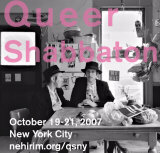 May 06
May 06
Aliyah: Trans(Per)forming Jewish Ritual
Luke Dzmura
The body is nothing more than a garment. When they are naming souls in the upper world and they call out “So-and-So, the daughter of Such-and-Such,” no body yet exists, not even in the womb. Not only that—what about the couplings in Heaven? The books of the kabbalah are full of couplings—face-to-face, back-to-back—all of them mysteries of mysteries, secrets of secrets. --Isaac Bashevis Singer, Androgynos
I. The Social Hall: Creation
Let’s say I meet you at Kiddush. When you and I shake hands for the first time, I am primarily concerned with what I call “the gender of first impression.” Who will you shake hands with? You will see a conservatively dressed, chubby, white man of medium height, with glasses and a goatee. If you typically employ gaydar, it will start to chime. A combination of clothing, hairstyle, voice, and facial hair creates “male” as the gender of first impression, and hopefully it “sticks”: no matter if five minutes later I tell you I spent thirty-five years as a female, you will think of  me first as male, and you will see the other years as an aberration. In other words, to you, henceforward, I am “really a” man. That’s good. The reality is more complex, but it’s solid ground for our first meeting.
me first as male, and you will see the other years as an aberration. In other words, to you, henceforward, I am “really a” man. That’s good. The reality is more complex, but it’s solid ground for our first meeting.
That’s my favorite scenario. There are others. Your perception matters as much to my identity as does my own. Gender is relational; gender is a dance, a team sport, social intercourse. In the best of all possible worlds, I can choose to live stealth; I can choose to come out. In the real world, sometimes you make that choice for me if you are either a) exceptionally observant or b) savvy to gender variance. For a transperson, each option carries a penalty.
When I choose to “live stealth,” the weight of the hidden part acquires a gravity that constrains my ability to interact with you socially. I’ll avoid behavior that might label me “feminine.” If you ask me what I think of the hummus, I’m not likely to share my recipe with you, because I’m afraid you might see me as possessing “too much feminine knowledge.” You might start to see a girl under my carefully constructed masculinity. I can’t risk that. The rabbis built fences around the Law in Talmud. So, too, I build fences onto my gender expression. Protecting the ambiguous living kernel of truth. So my years of experience as a good cook go by the wayside in order that I might appear to you as unambiguously “male.”
Does this help you to see the “gravity well” that the hidden part of my identity generates? It gets hard to lug that unwieldy invisible thing around, and it can crash into things and wreak unexpected havoc. It can even get me killed.
When I choose to come out, and tell you I changed genders, I can see the very instant I become “not a real man” reflected in your eyes. And when I choose to reveal my female past to you, no matter how liberal your politics, you feel you have been misled, and that I have deceived you. You were talking to a dude. Hell, let’s be frank: you were hitting on me. And now, … whoa … he’s really a …! It is painful for me to watch you respond with shame—your face gets red, you stammer, you stumble with pronouns—and for you, I become a really hairy, butch woman (not that there is anything wrong with that but of course it’s outside the attraction spectrum for most gay men) .
The loss of three quarters of my life experience is the penalty for hiding. The loss of my authenticity as a man is the penalty for coming out. Those are not acceptable losses.
And that doesn’t even bring into the equation the possibility of your violent response to me. Gwen Araujo was murdered in 2002. Biologically male, Gwen lived as a woman. As reported by the San Francisco Chronicle (May 30, 2004), her murderers stated that Ms. Araujo had deceived them into thinking she was a woman. They claimed the “transgender panic” defense, the argument of which is, roughly, that Gwen deserved to be killed because she deceived, and thus stole the heterosexuality of the men she had sex with. Notice how Gwen – and any transperson--is in a double bind. Either she is labeled a “deceiver” if she presents herself as female, or as a "pretender" if she presents herself as a transwoman (“Oh, I get it. You’re NOT REALLY a woman. You’re really a man”).
We should watch carefully those places where we give someone no option but to be a deceiver or a pretender, where no categories for recognition are allowed. Those places are clues that indicate when and where our culture doesn’t fit us any more. These are the cracks queer lives fall between. Disruption of the “gender binary” on as many fronts as possible is necessary to make space for queer lives.

For some reason, knowing a person is transgender doesn’t tell us enough of the story. Even if I am ‘in the know’ I still want to ask “The Question”. What is “The Question”? If she were a drag queen, the name of that question would be “Eurelia Mann” and her cousin “Chaveleh Surgery.”
We see it as our right to make a genital assumption about every person we meet. Genital status is in the public domain. Our binary clothing styles are a genital code. We crack the code without thinking about it. Being able to make the genital assumption about people adds a degree of predictability – of social safety – we take for granted.
Even though that information is held at a subconscious level, we go on trolling for it until we find out. Transpeople confound that system, and compromise our safety. Transpeople are dangerous.
So here I am at Kiddush, shaking your hand, and all these thoughts are swirling. There is something like the metaphor of the “closet” to these thoughts. Something like the closet, but smellier.
II. The Public Restroom: Revelation
You and I exchange small talk for a minute after we shake hands. Then you excuse yourself and I move on to the next introduction. Another minute with a blue-haired bubbe who thinks I am a yeshiva bocher and a good prospect for her granddaughter, and I am ready for a change of scenery. I swallow the last bite of challah and excuse myself from the social hall. A few steps down another corridor, I open the door to the men’s room.
I feel the familiar discomfort any transperson feels in the public restroom (there is no place for me, since I am not a woman and I am not biologically male; I am anxious at being “outed”). You are standing at the urinal. You heard the door open, but we don’t make eye contact. There is another urinal but I walk into the stall and close the door.
 In here, one must be all male, all the time. After all, that’s what the sign says: MEN. I am hiding in the open. Think too closely about it and I start to recognize (It’s a lie! Your body is lying!) I’m not really welcome here, and if folks knew, like as not I’d be out on my kiester (or worse). (You have deceived me!)
In here, one must be all male, all the time. After all, that’s what the sign says: MEN. I am hiding in the open. Think too closely about it and I start to recognize (It’s a lie! Your body is lying!) I’m not really welcome here, and if folks knew, like as not I’d be out on my kiester (or worse). (You have deceived me!)
I stand with my back to the stall door and close my eyes. The lack of a space designated specifically for a person of one’s own gender takes this most private of activities and makes of it an anxiety-ridden gender performance. There is no “relief” in the act of relieving oneself; no rest in the restroom.
It comes to me then that the public restroom might be to transgender persons what the closet is to queers. The closet, extended into three dimensions: the public water closet.
But there are differences. First, when I am “in the closet” as a gay man I am not actually hiding in a two-foot-by-four-foot enclosure in my bedroom, as I am now, in the water closet. The gay closet is a metaphor; a virtual location for an “identity”, a non-corporeal aspect of personality. The closet’s unreality reinforces the notion that gay and lesbian bodies are not different from heterosexual bodies unless and until they transgress gender boundaries. But this closet is real.
Second, while gay and lesbian identities are said to be located in “the closet” or “out” of it, a stigmatized gender presentation can hardly be excised and located elsewhere. Gender ambiguity may be hidden or camouflaged, but the hiding (and the revelation) is always ever incomplete in as much as it doesn’t tell the whole history of a body. Gender is about the embodiment of identity in a way that sexual orientation is not; gender is a physical as well as a psychological and/or perceptual phenomenon. If a queer person must “pass” for “straight” to gain access to the public facilities, a transperson must pass both for straight and for “male” or “female” in order to enter the public facility. The rule is “One Body, One Gender.”
As a transperson in the public restroom, some part of one’s gender identity is held in reserve; the “fit” is always imperfect. If one fails to pass, it is not a failure of attitude or “orientation” (which may be hidden) or proper clothing or accessories (which may be removed), it is a failure of one’s body.
The Talmud says we can’t think about Torah in the bathroom (BT Shabbat150a), but we must. My shul repeats and emphasizes that its lineage of inclusion hearkens back to the roots of Judaism, that the passion and love of God at the heart of Judaism contains some truth for all peoples. My shul says that it subscribes to the deepest intentions of the rabbis who founded Judaism, invented the Kabbalah, and documented Beshtian Hasidism. Of course, that’s a lot of rabbis and a lot of opinions. We judge “authenticity” by being able to trace lineage back along one path; my shul’s claims, like my own, are multiple and conflicting. I experience the same inauthenticity or lack of nuance when I say, without qualification, “I am a man.” It’s impossible to be both simple and authentic when several conflicting yet truthful narrative voices (I was a woman I am a man; we claim lineage with the BESHT, we follow the Sages) complicate reality. My shul faces the same lack of authenticity in claiming its diverse and pluralistic lineage when the experience we have in shul points to One Undifferentiated Truth. What havoc might be wrought by identities hidden in the closet and hidden-in-the-open in the public restroom?










